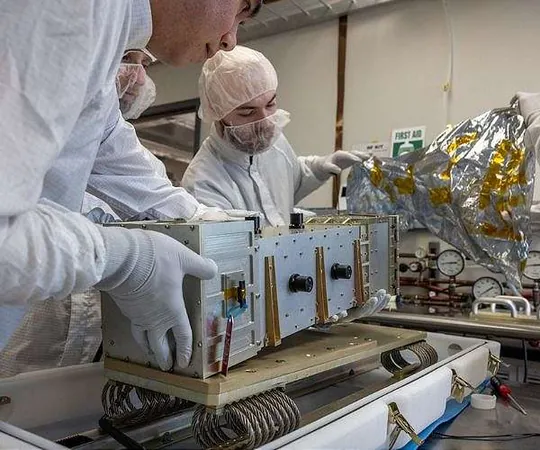
Get Ready for an Epic Space Mission: NASA’s LEXI Will Unveil Earth's Magnetic Secrets!
2025-01-05
Author: Siti
NASA's Upcoming Mission: LEXI
NASA is gearing up for an unprecedented scientific adventure as it prepares to launch the Lunar Environment Heliospheric X-ray Imager (LEXI) to the Moon. This groundbreaking instrument will provide the first-ever global images of Earth's magnetic field, an essential shield safeguarding our planet from harmful solar radiation.
Launch Details
Scheduled to launch no earlier than mid-January, LEXI is one of ten innovative payloads included in the Commercial Lunar Payload Services (CLPS) initiative. Its voyage will begin at NASA’s Kennedy Space Center in Florida aboard Firefly Aerospace's Blue Ghost Lander. The mission is a key part of NASA's Artemis program, which aims to establish a sustainable human presence on the Moon and deepen our understanding of various cosmic phenomena.
Mission Objectives
Once LEXI lands on the lunar surface, it will spring into action, collecting data over six days about the X-rays emitted from the edges of Earth's magnetosphere. This boundary is not just a shield; it plays a dynamic role in how Earth interacts with the solar wind—streams of charged particles emitted by the Sun. LEXI's unique position on the Moon will allow it to capture a comprehensive view of the magnetopause, the edge of our magnetic shield, offering insights into how it flexes and responds to solar forces.
Scientific Significance
Brian Walsh, the principal investigator for LEXI and a space physicist at Boston University, emphasizes the significance of this mission: “We're trying to get this big picture of Earth's space environment. This is science that everyone can visualize and understand!”
Investigating Magnetic Reconnection
Importantly, LEXI aims to unveil the mysteries behind phenomena like magnetic reconnection—events where the magnetosphere's field lines merge with the solar wind's lines, releasing energetic particles that can create breathtaking auroras in Earth's atmosphere. But it’s not all about beauty; these high-energy particles can also be disruptive to satellite systems and even impact power grids. Understanding this delicate balance is crucial for national security and infrastructure protection.
Future Impact on Space Weather Research
For the science community, this mission holds the promise of delivering answers to complex questions about space weather dynamics. “We expect to see the magnetosphere breathing in and out for the first time,” notes Hyunju Connor, an astrophysicist from NASA’s Goddard Space Flight Center. “When the solar wind strengthens, the magnetosphere compresses. We want to capture those changes and understand how they affect everything from our satellites to auroras.”
LEXI's Journey
Remarkably, LEXI isn't a completely new project. Initially created as the STORM instrument, LEXI had a previous, albeit short-lived, journey into space aboard a sounding rocket in 2012. Upon its return, it was stored away, gathering dust until NASA’s CLPS initiative brought it back to life with a few upgrades. “It’s like unearthing a hidden treasure,” says Walsh, “and now it’s ready to capture a global view that we’ve never had before.”
In Conclusion
NASA's CLPS is a forward-thinking initiative aimed at fostering collaboration with commercial lunar delivery services, stimulating industry growth while supporting long-term exploration goals. Through this partnership, NASA is not just paving the way for lunar exploration but also building a foundation for future interplanetary missions.
With the LEXI mission on the horizon, the scientific community—and indeed the world—waits with bated breath. This launch could redefine our understanding of Earth’s cosmic environment and how it shields us from the swirling forces of space. Stay tuned for this electrifying leap into the great unknown!

 Brasil (PT)
Brasil (PT)
 Canada (EN)
Canada (EN)
 Chile (ES)
Chile (ES)
 Česko (CS)
Česko (CS)
 대한민국 (KO)
대한민국 (KO)
 España (ES)
España (ES)
 France (FR)
France (FR)
 Hong Kong (EN)
Hong Kong (EN)
 Italia (IT)
Italia (IT)
 日本 (JA)
日本 (JA)
 Magyarország (HU)
Magyarország (HU)
 Norge (NO)
Norge (NO)
 Polska (PL)
Polska (PL)
 Schweiz (DE)
Schweiz (DE)
 Singapore (EN)
Singapore (EN)
 Sverige (SV)
Sverige (SV)
 Suomi (FI)
Suomi (FI)
 Türkiye (TR)
Türkiye (TR)
 الإمارات العربية المتحدة (AR)
الإمارات العربية المتحدة (AR)